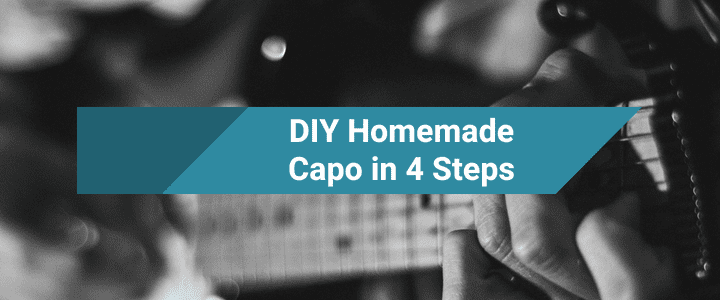
If you want to learn how to make your very own homemade capo from scratch, keep reading. In this article, we’ll share four simple steps to put together a DIY capo on the fly – with just two materials!
When you’re jamming with friends and there’s a new vocalist in the mix, you might find yourself having to play in unfamiliar keys. If you left your trusty capo at home, no problem! Follow this easy guide and you’ll learn how to make a capo in no time.
DIY Homemade Capo Tutorial
You can solve the key-change conundrum with relative ease if you know how to make a capo on the fly. Essentially, you need a rigid strip of material that can be clamped onto the neck of your guitar.
Here are the materials you’ll need:
- A pencil or sharpie
- 2-4 rubber bands (medium thickness)
Yes, you only need two simple materials for this homemade capo. If you can’t find rubber bands, a good alternative is a hair band.
Now that you have all you need, here are the steps for how to make a capo.
Steps to Make a DIY Capo
- Make sure your guitar is in tune.
- Place the pencil or marker upon the desired fret.
- Fold the rubber band in half and loop it over both ends of the pencil.
- Add more bands as needed to achieve the desired tension. Check this by plucking each string and listening for a clear tone.
That’s it! This is such an easy way to put together a homemade capo on the fly, with materials that are readily available. Need to see the process demonstrated visually? Watch the steps in the quick video below:
5 Reasons Every Guitarist Needs a Capo
Now let’s take a look at some of the benefits of using a capo, in case you weren’t already convinced that you need one.
- A capo creates a moveable nut or barre. For example, if you place the capo on the second fret, you’ve moved all the chords up one step (a C is now a D).
- It allows you to play chord shapes that you’re already familiar with, but in a different key. So with a capo, a bit of transposing savvy, and a handful of chords, you can play some previously hard to reach tunes.
- Using a capo allows you to explore different chord voicings, or inversions, which can make a chord sound brighter or darker, and add interest to picking.
- It is helpful for changing tunes to a more comfortable range, or key, for vocals.
- A capo adds depth when playing with other guitarists. Some can play open chords while others place capos at different locations, which creates a broader sonic range and textural interest.
Now you know some of the benefits of using a guitar capo, so even if you’re only slightly familiar with this tool, you can begin exploring its capabilities.
You’ve also learned how to make a capo very quickly and easily if you wish to try out these concepts without spending any money.
While practicing your skills, be sure to look into private guitar lessons or online guitar classes to help you achieve your musical goals, as personal feedback is a very important part of the learning process. Have fun with your DIY capo, and rock on!
 Post Author: Tracy D.
Post Author: Tracy D.Tracy D. teaches guitar, drums, piano and more in Edmond, OK, as well as online. She’s been teaching since 2010 and has her Bachelor’s in Music Education from Oklahoma Christian University. Learn more about Tracy here!
Original article is here:Take Lessons
No comments:
Post a Comment